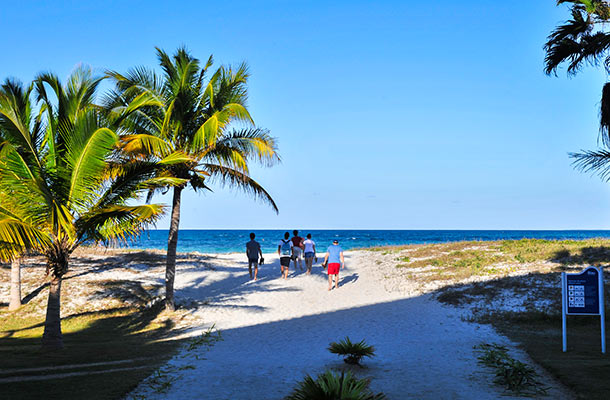Swap the photogenic streetscapes of Havana for tiki bars and palm-fringed shorelines with our local insider Caroline’s favorite day trips.
 Photo © iStock/jimfeng
Photo © iStock/jimfeng
Playas del Este
If you can get over the Soviet-era eyesores that blot the coastline, the Caribbean beaches of Playas del Este are as good as any tropical fantasy.
Santa María del Mar (18km from Old Havana) is the most tourist-oriented beach.
There’re palm-fringed beaches and tiki bars serving potent mojitos, comfy sun loungers, an array of watersport facilities, and a constant beat of salsa, Playas del Este is an atmospheric place to hang out and watch Cubans flirt and play.
Further east, the dune-backed Boca Ciega, 27km from Havana, is a big hit with Cubans who converge en mass at the weekend.
If you want to travel with the locals, you can take a train from Havana’s Estación Central (40 pesos), but if you are short of time, a taxi will set you back around US $15.
Varadero
With sugary white sands lapped by translucent sapphire waters, Cuba’s Varadero peninsula has lured European package tourists for decades.
Sure, if you are a fan of conventional mass tourism, what’s not to love: behemoth, all-inclusive hotels with mega pools, kid’s clubs, and notoriously dire buffet food stand sentinel along a 20km expanse of wide sandy beach.
The remote, far eastern end of the peninsula is where the most expensive upscale resorts (often adults-only) are located, while scruffy Varadero town supports low-end hotels that cater to vacationing Cubans.
Six miles out to sea, the Ojo del Mégano (or ‘Blue Hole’) dive site quickens the pulse of scuba enthusiasts, with its rich marine life including barracuda, red grouper, snapper, and lobster.
To get to Varadero from Old Havana, the most cost-effective way is to take the Viazul Bus (CUC $4, 3h). A taxi is much quicker (1.5h) and will cost around CUC $90.
Matanzas
Known as the ‘Athens of Cuba,’ Matanzas has a lot to live up to.
Bisected by the San Juan and Yumurí rivers, the city and its nearby natural attractions, including the Bellamar Caves (famous for their calcite crystal formations), remain a popular stopover for travelers en route to Varadero.
During the city’s 19th-century heyday, many of Cuba’s pre-eminent writers, painters, poets, and musicians were born here, and two distinctly Cuban musical forms – danzón and rumba – were first composed in this very proud city.
While you do need to look hard, Matanzas’s creative spirit still lingers beneath.
Matanzas’s sights are sprinkled through its inviting colonial core, where neoclassical buildings nudge up against gilded churches and colonial landmarks. The city’s architectural highlight is the Teatro Sauto (1863), one of Cuba’s greatest theaters, lauded for its excellent acoustics and lavish decor.
There are three buses a day to Matanzas with Viazul from Havana (CUC $3, around 2h).
Scuba Diving Near Havana
As the largest island in the Caribbean Sea, Cuba’s 5,600km coastline is home to some of the world’s most pristine coral reefs.
A keen diver himself, Fidel Castro was well ahead of the game when it came to marine conservation.
Just a short taxi ride from Havana, there are more than 30 dive sites, including wrecks, caves, and coral gardens for novice and advanced divers.
The region’s most famed dive site is Boca de Caldera (Mouth of the Cauldron) where calm waters and excellent visibility yield an underwater garden of mesmerizing sea fans, sponges, and coral.
Wreck diving specialists can explore the vibrant coral gardens that surround the Sanchez Barcastegui, the remains of a 19th-century Spanish battleship which sunk to 25m following an unfortunate collision with another ship.
Or explore The Coral Island – a merchant ship with a hulk that was spliced into three separate sections when it ran aground following a fire – now a haven for colorful marine life.
The Hemingway Trail
All Hemingway devotees should make the pilgrimage to Hemingway’s atmospheric Finca La Vigía estate, 15km east of Havana in the town of San Francisca de Paula.
This is where Hemingway lived from 1940 to 1960 and penned reams of The Old Man and the Sea and For Whom the Bell Tolls, reopened in 2007 as a museum following extensive restoration works.
The house is riddled with the troubled author’s obsessions and rituals. There’s Hemingway’s writing on his bathroom wall where he logged his weight every day, his Royal typewriter propped up on a bookshelf in his bedroom (he wrote standing up due to chronic back problems), Spanish bull-fighting posters, hunting trophies, and memorabilia from his numerous African safaris.
In the 15-acre grounds, you can check out Hemingway’s beloved wooden fishing boat, Pilar, the graveyard where Hemingway buried his creatures, including over a dozen cats, a cock fighting ring, and the swimming pool where Ava Gardner once swam naked (‘this water can never be changed,’ Hemingway reputedly decreed).
Following Hemingway’s departure to the US in 1960 as a lonely, manic depressive on the verge of suicide, Castro appropriated the house and all its belongings with it.
To reach San Francisco de Paula, you can take a bus from Parque de la Fraternidad in Centro Habana and get off in San Miguel del Padrón; the house is located 200m east of the main road.
Heading to Cuba? Download our FREE Insider’s Guide!
Related articles
Simple and flexible travel insurance
You can buy at home or while traveling, and claim online from anywhere in the world. With 150+ adventure activities covered and 24/7 emergency assistance.
Get a quote
No Comments